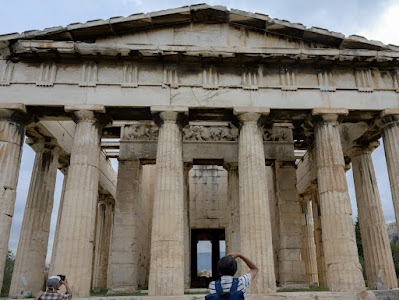Chicago, day 4, Oak Park and Frank Lloyd Wright
In spite of now staying in central Chicago we travelled out to the Oak Park suburb where Frank Lloyd Wright, the innovative American architect, built his family home and studio. We naturally went on the 'L' train, giving me more photo opportunities, especially where the train seems to do an almost 90 degree turn around the buildings.
You can only see the Frank Lloyd Wright house by guided tour. I had a 'photo' ticket which allowed me to take pictures after all the other tourists had left the particular room we had been in. Luckily there was only one other person with the same sort of ticket, otherwise I would have been no better off!
Wright was born in Wisconsin in 1867. His mother Anna ordained that her son would build beautiful buildings and accordingly decorated his nursery with engravings of English cathedrals. She also purchased a set of Froebel blocks, wooden blocks in geometrical shapes that can be used to make three dimensional compositions. Wright claimed that the hours spent playing with these gave him a good geometric grasp of design. Anna was a teacher and when Wright was 14 she told Wright's father to leave as he was no provider for his family. Wright never saw him again. Consequentially, as the only male in the family Wright felt he should help provide for his mother and two sisters.
He enrolled at the University of Wisconsin-Madison to study civil engineering, and in order to cover his tuition fee assisted the architect Joseph Silsbee in the construction of the Unity Chapel. He decided to become an architect rather than an engineer, dropped out of college and moved to Chicago which was being reconstructed after the great fire. He got a job as a draughtsman with Silsbee's firm. They did not pay him much so he left a year later and was apprenticed to the firm of Adler and Sullivan. Sullivan was a very famous architect who is known as 'the father of skyscrapers'. In spite of altercations between them, Sullivan gave Wright greater design responsibilities and spent much time encouraging his talents. Wright helped with the design of the Auditorium Building and when Sullivan moved his firm to that building Wright had an adjoining office to Sullivan. Here Wright worked on their commercial projects during the week, but spent weekends on designs for the residential properties of their clients, as Sullivan was humouring the clients but did not want to impinge on the more important work of the office.
Wright met his first wife, Catherine in 1889 and he persuaded Sullivan to loan him $5,000 to build a house in Oak Park, on the condition that he worked for Sullivan for a further 5 years. Wright's expensive tastes in clothes, vehicles and the money he poured into the house saw him getting into further debt. Consequentially he started to take on private work, or his 'bootleg houses' as he called them. About 9 of these properties had been built when Sullivan finally recognised the hand of the designer when a house went up not far from his own dwelling. As this contravened the terms of his contract, an offended Sullivan sacked Wright and refused to give him the deeds to his house in Oak Park until the 5 years was completed. Wright claims that he had walked out of the job after being told he could not undertake any further private work. Whichever was the case Sullivan and Wright did not speak for 12 years.
Wright first set up an office in downtown Chicago but in 1895, probably to save money, decided to work from home. With the birth of 3 children, home became a little cramped so Wright built a studio alongside his house, which was an advertisement for his architectural aesthetic. He had 7 draughtsmen and women working there and by 1901 had completed 50 buildings, many of them houses around Oak Park. Here he developed his 'prairie style, where the house, long and low, fits into the landscape and cantilevering is used to provide large unhindered spaces within the building.
I shall now post some photos of the house and studio and come back to Wright's more salacious life story in the next blog. First some pictures of the exterior of the house. In summer it would be difficult to get a good views of it.
We started our tour on the ground floor where we saw the sitting room, study, dining room and pantry. The dining room was once the old kitchen. Wright expanded the house to meet the needs of his family as he eventually had six children with Catherine. As you can see everything is harmonious with simple colours blending with the wood of the house, which is omnipresent. The ground floor is almost open plan with wide spaces between each room. Some of the stairs were quite tunnel like. Wright wanted to achieve a greater feeling of space in some of the rooms by squeezing you out into them.
We now went outside and into Wright's studio. The room where the draughtsmen worked is very impressive. The roof is domed, allowing for extra light and the balcony is held by a series of chains which lends a more open space. These pictures are followed by an image of the dark stained reception hall with its stained glass roof light. Then I have some pictures of the octagonal library and one of Wright's office. The chairs are very modern in design, but even Wright admitted they were not comfortable. The internal passage between the house and the studio has a tree growing through it which Wright did not wish to cut down and shows the organic nature of the house.
The sources of this blog are the Frank Lloyd Wright Trust, http://www.biography.com/people/frank-lloyd-wright the Independent http://www.independent.co.uk/arts-entertainment/architecture/architect-of-desire-frank-lloyd-wrights-private-life-was-even-more-unforgettable-than-his-buildings-1637537.html and Wickipedia.


























































Comments
Post a Comment